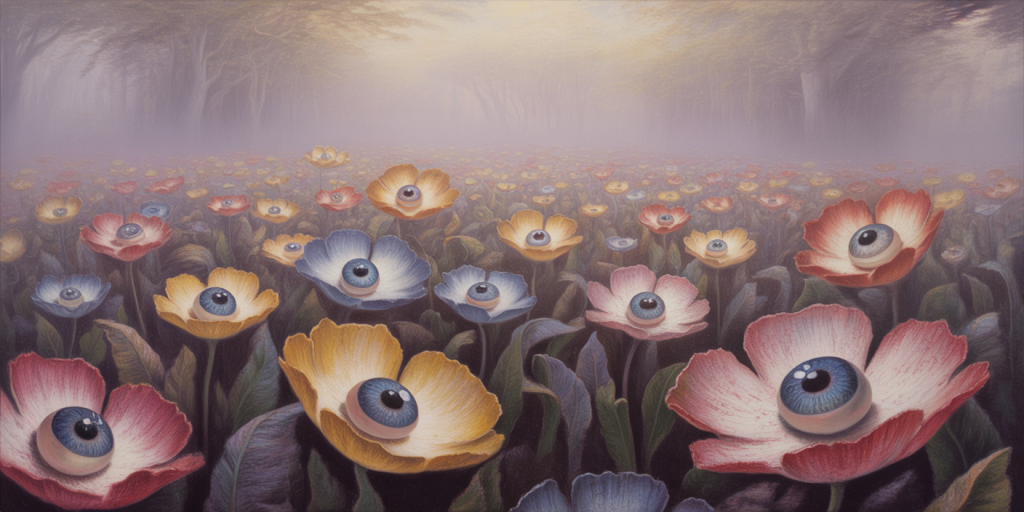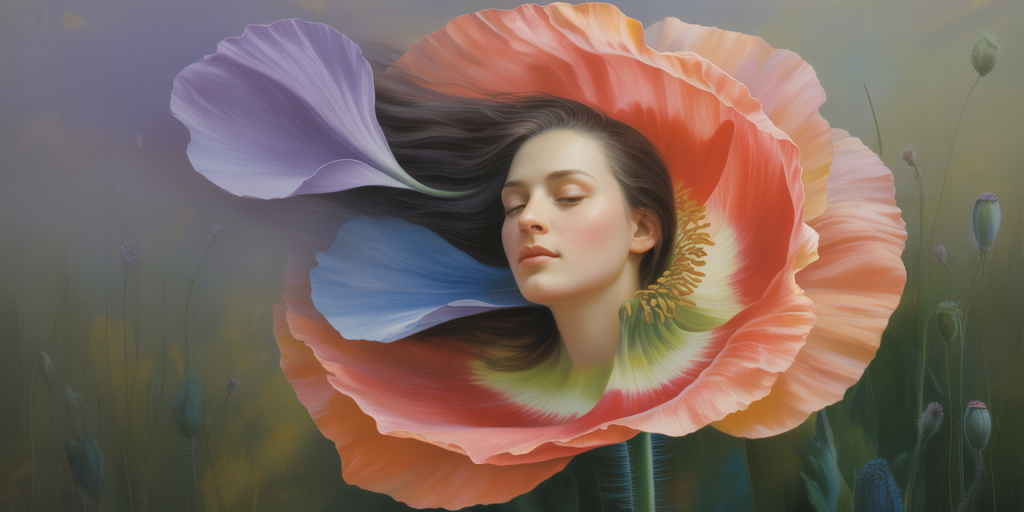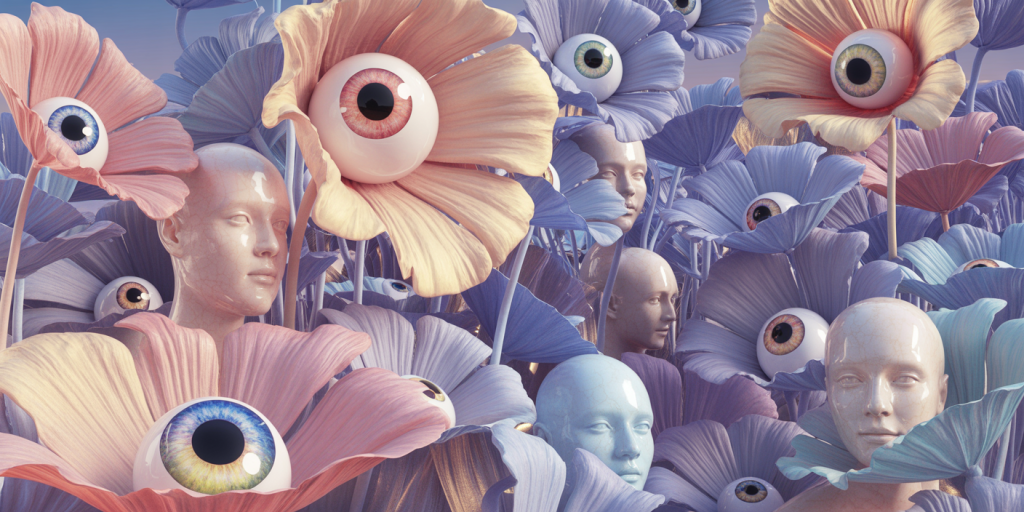Redon and the Eyes That Bloom from Imaginary Gardens
There are paintings that speak. Others hum, sigh, or whisper. And then, there are those that gaze back. In the works of Odilon Redon, the canvas is not simply a mirror of vision, but a breathing garden of perception. Flowers open like pupils. Seeds swell with dreams. In his universe, color is not seen—it is sensed, tasted, inhaled. And from petals, from roots, from shadowed foliage, eyes bloom.
To witness a Redon is to feel yourself observed by the very world you thought you were beholding. His creations are neither real nor fully imagined, but born of a threshold where the subconscious leaks into color. His gardens do not grow in soil, but in silence. Each blossom, each hovering orb, becomes a meditation on what it means to see, to feel, to remember through the language of color.
Table of Contents
- Eyes Among Petals
- Dreams-That Drift in Pigment
- The Scent of Unspoken Light
- Silence Wrapped in Bloom
- Figures That Flower
- Shadows with Lashes
- The Emotional Garden
- Chromatic Prayers
- The Mystery of the Floating Head
- The Touch of Dust and Spirit
- Wings that Whisper in Pollen
- The Face in the Stem
- Echoes of Symbolist Solitude
- The Canvas as Vision Organ
- The Gaze of Plants
- Palettes Dipped in Reverie
- From Charcoal to Petal
- The Psyche Hidden in Pinks and Blues
- When Flowers Begin to Speak
- Memory Rooted in Mystery
Eyes Among Petals
Redon’s flowers do not merely bloom—they watch. Eyes open from the center of roses, gaze out from the throat of orchids, blink softly from violet shadows. These are not metaphors, but meditations: a statement that vision lives everywhere, even in stillness. The garden sees you.
Dreams That Drift in Pigment
Every stroke in Redon’s work feels like a moment recollected from sleep. The colors are not solid but shifting. Blues trail into saffron, reds dissolve into wind. These pigments do not define form, they dissolve it, allowing dream logic to reign.

The Scent of Unspoken Light
Light in Redon is never harsh. It radiates like memory, muted and golden. It glows behind the veil of atmosphere, more scent than beam. The way it clings to the edge of a figure or the curve of a petal evokes reverence—as if each hue remembers where it came from.
Silence Wrapped in Bloom
Redon’s silence is tangible. His compositions hum with quiet. Figures emerge without gesture; flowers glow without shout. The silence is not emptiness, but presence: a gentle insistence that beauty does not need to explain itself to be felt.
Figures That Flower
In his work, figures grow like flora. Heads appear without bodies, or fused with branches, as if the soul had outgrown flesh. These human-floral beings do not disturb; they console. They speak of transformation—of life not ending, but becoming botanical, luminous.
Shadows with Lashes
Even darkness in Redon’s palette feels alive. His shadows pulse, as if breathing under the surface. They do not smother but frame the wonder. They are not mere absence of light, but presences of thought. Some even sprout lashes, subtly suggesting that shadows too can see.
The Emotional Garden
His landscapes are never merely topographical. They are emotional states, fields of feeling. A single tree against indigo sky might evoke longing. A small path bordered by ochre might murmur nostalgia. In Redon’s gardens, we do not walk—we feel our way forward.
Chromatic Prayers
His use of color resembles devotion. Each tone is applied not to illustrate, but to sanctify. Violet becomes a psalm. Vermilion—an offering. His floral portraits read like prayers whispered in color, and the viewer becomes witness to a sacred bloom.
The Mystery of the Floating Head
Perhaps Redon’s most haunting motif is the disembodied head, adrift in floral ether. These faces seem both angelic and vegetal—serene, but unmoored. They symbolize the fragility of identity, the way thought can detach from matter, like a petal from its stem.

The Touch of Dust and Spirit
Redon’s technique often blends pastel and charcoal, creating a texture that seems part matter, part spirit. The dustiness of his medium evokes breath, dream, dissolution. Each mark feels temporary, like something left behind by a wing.
Wings that Whisper in Pollen
Winged creatures—angels, butterflies, abstract spirits—flutter across his canvases. They do not invade; they arrive. Sometimes vague, sometimes detailed, they hover with the softness of thought. Wings in Redon are never for escape. They are for drifting, lingering.
The Face in the Stem
In some of Redon’s compositions, the line between flower and face disappears. A bloom becomes a visage; a stalk becomes a throat. It is a visual theology of metamorphosis, suggesting that identity is both botanical and divine.
Echoes of Symbolist Solitude
Redon belonged to the Symbolist movement, yet his solitude within it is palpable. His works speak not with rhetoric but with murmur. Unlike allegory or myth, his paintings unfold like private monologues—introspections embroidered in color.
The Canvas as Vision Organ
For Redon, the canvas is not a window. It is an organ—a living eye through which both painter and viewer glimpse the sacred. His works become extensions of perception, amplifying what is felt but unseen.
The Gaze of Plants
In Redon’s world, plants do not merely grow—they contemplate. The twist of a stem, the lean of a leaf, all suggest intention. His flora are sentient, aware. They bow to unseen moons, they listen to internal music. They gaze.
Palettes Dipped in Reverie
His color choices evoke trance. Dusky greens, mournful mauves, sudden oranges that flare like memory. These are not the colors of daylight, but of reflection. The hues seem drawn not from tubes, but from dreams remembered just before waking.
From Charcoal to Petal
Redon’s evolution from monochromatic lithographs to exuberant pastels is a metamorphosis in itself. He moved from shadow to light, from skull to bloom. Yet even his colors carry the ghost of his blacks. His petals still remember the dark.
The Psyche Hidden in Pinks and Blues
Redon painted not what he saw, but what he sensed behind what was seen. His art is a psychology rendered in pigment. Pink becomes a longing unnamed. Blue becomes the ache of distance. Each work is a quiet psyche revealing itself in flowers.

When Flowers Begin to Speak
Redon’s art often suggests that flowers, if listened to closely, can whisper. They speak not in words but in hues and scent, in angle and bloom. Their language is not deciphered but felt. To enter his garden is to learn this speech.
Memory Rooted in Mystery
His works are memories that never happened, recollections from lives never lived. They pull at something ancestral. His flowers, his eyes, his floating heads—they do not ask to be understood. They ask only to be remembered.
FAQ
Who was Odilon Redon?
Odilon Redon (1840–1916) was a French Symbolist painter and printmaker. Known for his visionary pastels and charcoal drawings, Redon’s work explores dreams, spirituality, and the subconscious.
Why are eyes such a frequent motif in Redon’s art?
Eyes in Redon’s work symbolize consciousness, observation, and inner life. They often appear in unexpected places, suggesting that vision is a universal, spiritual act.
What techniques did Redon use?
He used charcoal (in his early “noirs”), lithography, and later pastels and oil. His textures are soft, atmospheric, often blending forms into ethereal dreamscapes.
Was Redon part of any art movement?
Yes. He is associated with Symbolism, a late 19th-century movement that emphasized internal vision, mystery, and the spiritual over realism.
How should one interpret Redon’s floral works?
Rather than botanical studies, Redon’s flowers are expressions of mood, psyche, and spirituality. They embody feeling more than form.
Final Reflections: When the Garden Gazes Back
Odilon Redon painted what blooms in silence. In his gardens, the eye is not merely the observer—it is the flower, the soil, the sky. His art does not depict vision; it becomes vision. A floating head, an eyelash in a leaf, a petal stained with sorrow—each detail reveals that beauty is not merely to be seen but to be felt watching you.
In Redon’s imagined gardens, we are not visitors. We are part of the dream. Rooted. Gazing. Blooming with unseen eyes.
